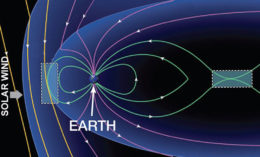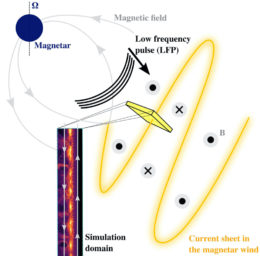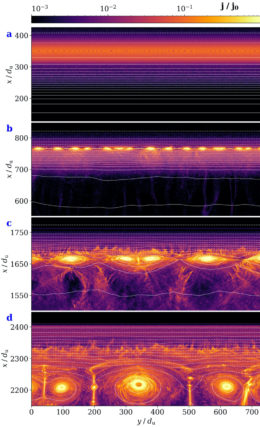In the wild world of fast radio bursts, we may finally be converging on an explanation of what causes these outbursts. Is the answer magnetic reconnection, a phenomenon that occurs everywhere from the Sun to Earth’s magnetosphere?

An illustration of magnetic reconnection in Earth’s magnetosphere. The solar wind puts pressure on Earth’s magnetic field lines, causing them to reconnect with the solar wind magnetic field. They’re then peeled back by the motion of the solar wind to the night side of the planet, where they reconnect. [NASA]
Making a [Re]Connection
Fast radio bursts are one of the hottest topics in astronomy at the moment. These millisecond bursts of radio emission first erupted onto the scene in 2007 and, since then, they’ve continued to puzzle astronomers with their many mysteries. The leading picture of how fast radio bursts are produced suggests they’re caused by flares of electromagnetic radiation from magnetars. Magnetars are neutron stars with such high magnetic fields (some of the strongest in the universe!) that if a magnetar was situated between Earth and the Moon, it would wipe out all of our credit cards and hard drives. A team led by Jens Mahlmann (Princeton University) has taken this idea a step further, positing that fast radio bursts could be caused by magnetic reconnection in the plasma flowing outward from a magnetar.

A diagram of the magnetar wind and the current sheet that ultimately causes reconnection. [Adapted from Mahlmann et al 2022]
Pressure That’ll Tip, Tip, Tip ’til [Magnetic Field Lines] Just Go Pop
Magnetic reconnection occurs when stressed magnetic field lines snap and come back together, releasing energy as they do so. Think of a rubber band: when you put pressure on a rubber band by stretching it, its elastic potential energy is converted into kinetic energy when the rubber band is released. The same is true with magnetic reconnection: pressure is put on field lines until they snap into a new configuration, transferring magnetic energy into kinetic energy. This energy of “snapping” throws electrons outward in two jets, flinging them into space. This phenomenon is seen in many systems throughout the universe, including in solar flares and in our own magnetosphere, causing the northern lights. The energy released in reconnection can be tremendous — the energy contained in a gallon of a magnetar’s magnetic field is equal to the energy stored in 1018 gallons of gasoline — and it could provide enough energy to power the fast radio bursts that we’ve observed throughout the universe.

An example of simulations of the reconnection in the current sheets caused by magnetar flares. From panels (a) to (d), the current sheet gets more and more compressed, with magnetic reconnection beginning in (b). Note that time increases from panel (a) to panel (d) and the length scale increases as the pulse moves outward. The colors represent the current density. To see an animation of this figure, [click here]! [Adapted from Mahlmann et al 2022]
A Current Theory
To test the theory that magnetic reconnection is the source of fast radio bursts, Mahlmann and collaborators simulated the area around a magnetar that has a wind of plasma propagating from its surface (aptly named the “magnetar wind”). The authors investigated the outcome of a magnetar flare traveling through the magnetar wind and colliding with a current sheet — a region in which an electric current flows between magnetic field lines that point in opposite directions. They found that the magnetar flare would trigger a magnetic pulse, causing a compression of the magnetic field lines in the current sheet, which would then snap and reconnect. A fraction of the energy released would escape the wind as radio emission. The authors calculated that, given a strong enough magnetic pulse in the magnetosphere, the resulting radio burst would be bright enough to see outside our own galaxy.
This theory, which builds upon one of the leading explanations of how fast radio bursts are produced, might be the key to understanding these bursts. The simulations in this study are conducted in two dimensions, but the team hopes that future studies will explore the 3D realm of the intricate plasma physics that governs behavior near magnetars.
Citation
“Electromagnetic Fireworks: Fast Radio Bursts from Rapid Reconnection in the Compressed Magnetar Wind,” J. F. Mahlmann et al 2022 ApJL 932 L20. doi:10.3847/2041-8213/ac7156

